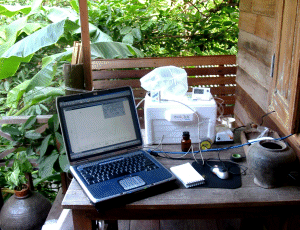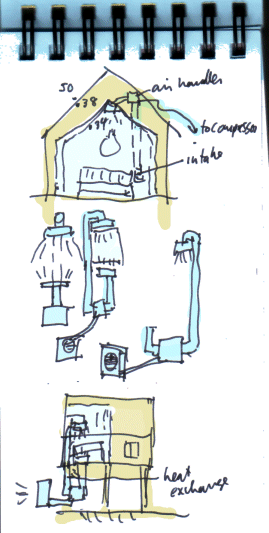 Dhamma. "Not using mosquito nets...was very beneficial. It helped us xpand our thinking, to feel unburdened, to wake up better, and to consider sleep as a temporary rest rather than a pursuit of or indulgence in comfort. It also helped us practice wakefulness to the best."
Dhamma. "Not using mosquito nets...was very beneficial. It helped us xpand our thinking, to feel unburdened, to wake up better, and to consider sleep as a temporary rest rather than a pursuit of or indulgence in comfort. It also helped us practice wakefulness to the best."Friday, November 16, 2007
Change your perception of, and attitude toward, discomfort
 Dhamma. "Not using mosquito nets...was very beneficial. It helped us xpand our thinking, to feel unburdened, to wake up better, and to consider sleep as a temporary rest rather than a pursuit of or indulgence in comfort. It also helped us practice wakefulness to the best."
Dhamma. "Not using mosquito nets...was very beneficial. It helped us xpand our thinking, to feel unburdened, to wake up better, and to consider sleep as a temporary rest rather than a pursuit of or indulgence in comfort. It also helped us practice wakefulness to the best."
Posted by
Dick Meehan
at
Friday, November 16, 2007
0
comments
![]()
Monday, November 12, 2007
Cool night sky

 An email from technology innovator Steve Baer reminded me of work by the solar master Harold Hay who invented and promoted a roof pond concept in California that relied on night radiative cooling to store "coolness" for the day use.
An email from technology innovator Steve Baer reminded me of work by the solar master Harold Hay who invented and promoted a roof pond concept in California that relied on night radiative cooling to store "coolness" for the day use.I built a "upcountry" room with a metal roof and zero ventilation and let it sit on my roof for a couple of days. Of course not a real room, but one of about a cubic foot size with a sheet of mat black aluminum foil for a roof and the room itself a foam picnic box that I bought for a buck at the Chinese shop down the street. Into which I put a brick for thermal mass and a hobo to measure temp and dew point.
 You can see the temp history of the country room in red and the temps of Jack's bedroom and the outside temp (last two almost the same) over several days. The country room is impossible in the daytime but gets really cool at night. At least toward the end of the test period when the dew point got fairly low and the night sky temp fell to as low as -5 degrees C. So you might be very happy with a simple tin roof at night -- though not at day. And, this being a dryish night, note that the suppresssed temp is still way above the dew point, so there will be no problematical condensation. The question being, how about during the hot season, when the dew points are a lot higher, maybe 18 C instead of 10 C? Would you get any radiative night cooling then? If so, would water start to drip from the ceiling?
You can see the temp history of the country room in red and the temps of Jack's bedroom and the outside temp (last two almost the same) over several days. The country room is impossible in the daytime but gets really cool at night. At least toward the end of the test period when the dew point got fairly low and the night sky temp fell to as low as -5 degrees C. So you might be very happy with a simple tin roof at night -- though not at day. And, this being a dryish night, note that the suppresssed temp is still way above the dew point, so there will be no problematical condensation. The question being, how about during the hot season, when the dew points are a lot higher, maybe 18 C instead of 10 C? Would you get any radiative night cooling then? If so, would water start to drip from the ceiling?By the way, I say test boxes--there were two of them. One had foil with shiny side down (the blue line) the other had the bottom surface of the foil spray painted mat black (red line). The shiny foil reduces the peak heat of the day but also slightly reduces the cooling effect of night radiation.
Posted by
Dick Meehan
at
Monday, November 12, 2007
2
comments
![]()
Saturday, November 3, 2007
In the cool of the pub

Sometimes the only place that seemd tolerable was a pub, so I spent time working in those fine places sipping Heinekens and sketching out my ideas on paper napkins. Sometimes I'd lose interest in thermodynamics -- I did poorly in it at college --and then I'd draw little pictures of the action around me, older guys like myself thinking and drinking or watching TV with their bored girlfriends picking at the fahlang food or patiently waiting, like rice farmers waiting for the rains.
I noticed that many of these girls had remarkably large hands.
Posted by
Dick Meehan
at
Saturday, November 03, 2007
0
comments
![]()
A one-watt air conditioner

Air conditioning for your pet mouse
Jack and Dah have a goal: no house air conditioning.
Air conditioning is notoriusly inefficient in Thailand, with typical split room-size air conditioners churning out 12000 BTU per hour (3000 watts) of cooling per room, mainly energy spent on cooling sun-heated walls and vaporizing moisture that freely enters the room from outside sources, all at a cost equal to 35 percent of a Thai college graduate's salary. Tankers of oil steam into the Gulf to meet this wasteful demand.
And of course with the light, leaky construction of a traditional Thai house an off-the-shelf machine would be even more inefficient.
So...while hanging around the pub one day I set out to reinvent the air conditioner.
Let's start not with a 3000 watt machine, or even a (say) 300 watt machine that would be arguably sufficient to cool Jack and Dah when they are sleeping. Let's start with the bench machine above, which I built for a couple of hundred baht, a one-watt air conditioner, which meets the following specifications:
cooling capacity (mostly latent): 1 watt
condensate, cc/hr: 1
unconditioned air water vapor entering machine: 20 g/cubic meter
conditioned air water vapor exiting machine: 8 g/cubic meter
Operation of this machine requires about 3600 joules of energy per hour, which can be easily provided by only about 10 grams of ice.
The question: can we effectively scale up, say by a factor of about 300? This would require about 3 kg of ice per hour--seems doable.
Posted by
Dick Meehan
at
Saturday, November 03, 2007
0
comments
![]()
Friday, November 2, 2007
Aircon fantasies
In times of general retreat I spent hours fiddling with air-conditioning ideas. Solar powered desiccants. Micro air conditioners like they used to cool yachts and space men and NASCAR racing drivers. I went to the annual southeast Asian air conditioning trade show at the Sirikit convention center. Eager Chinese salesmen filled my arms with lavish brochures. The brochures showed their company president, tan, fit, and shrewd, perfecting his golf swing. China was clearly the future of air-conditioning manufacture.
But what I wantedI couldn't find. That was, a device that would condition air for a couple of people, not cool a big leaky overheated Thai room that delivered 2000 watts of heat from walls heated by the afternoon sun and steamy outside filthy air through window framwes that didn’t fit right. I knew he was on the right track when I went to visit the Carrier office in Bangkok. They somewhat reluctantly sent an engineer out to talk to this fahlang with the short pants milling around the front desk. Could they offer small units, maybe 5000 btus or less, asked I?
"What you want for?" the engineer asked, his eyes narrowing suspiciously.
“For small room, maybe twenty, twenty five square meters.”
The engineer whipped out a calculator and pecked in some numbers. Multiplying something by twenty five. No wonder people are annoyed by engineers, I thought to himself.
"Twelve thousand. "
"Twelve thousand what, for what."
" BTU for room."
I said that I was amazed, amazing thailand, I said, that he could do this so quickly. He must have a very good college degree. I thanked him for his time in a rather exaggerated way that he hoped conveyed the general idea. This was a Thai trick he had learned.
*********************************
I thought some more on this subject that I was clearly thinking about too much.. This is what I am looking for, I thought:
The system would cool a large fahlang body, and maybe Dah too if Jack could ever get it together with her. It would cull a small space that was reasonably protected against radiant, convective heat transfer and moisture infiltration, either convective or diffusive. Maybe like a tent. I drew a sketch.
The air within would be dry, say 40 percent RH but not too cold, so maybe there would be some heat transfer between the incoming and outgoing air. The capacity would be only say 500 watts or 2000 BTUs per hour, half the size of a small US style window unit, 20 percent of the one that Mr. Wonton said was necessary because it was the smallest the Carrier company made. The electrical savings for say six hours of operation of a 2000 btu unit would be a dollar fifty a day. Half a million air conditioners were bought in Thailand every year. The space to be cooled would be small, maybe 25 cubic meters altogether, and the envelope would serve as a mosquito barrier as well. The air would be conditioned air would be ducted into the space silently.
And wouldn’t it be nice to power the whole thing with exactly that dreadful stuff that was causing the whole problem, the 1000 watts per square meter, that would be 36 kw of power, of sun power burning down on that hot red roof? Maybe putting all that heat into the ground or say a lithium salt solution or some ammonia like the old days under the house or hidden away in the garden and some of it into the cool 26 degree water that came in off the street so the shower would be nice in warm in the cool season when the sky is clear and the solar at a maximum?
They would call it the "Ron Swelters Quarter Ton Aircon Machine", dedicated to His Majesty the King who had shown a keen interest in energy savings, and also to Doctor Carrier who invented the first air conditioner to cool the fevered brows of malaria victims but who had been swindled out of his rewards by John "Ice King" Tudor. In the year 1831, it was.
This was getting good. I ordered another pint, it was three minutes before seven and the price would double if I didn’t, the waitress told me so.
***************
The following night I had dinner with Jack and Dah. I told them all about my air conditioning ideas.
"Oh, Khun Jack, that very good. "
Jack thought this would be a good time to sort of pop a question.
"You know, Dah", he said, "we have to make an important decision. W can do it with only 1000 btu. But maybe I should get extra, maybe 2000 btu. Just in case maybe things different in the future."
Dah considered this.
"I think you and Ron know best about this. We need more money in account."
Posted by
Dick Meehan
at
Friday, November 02, 2007
0
comments
![]()
